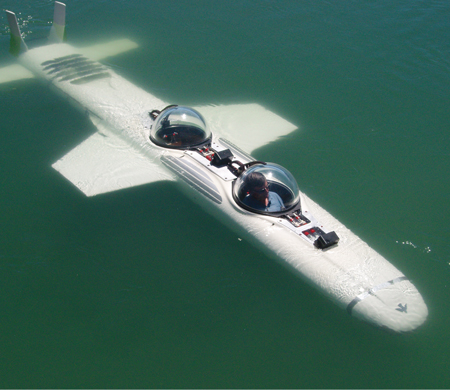Frank Sinatra once crooned “come fly with me, let’s fly let’s fly away.” His enticements included a trip to llama land, a one-man band, and a bar in far Bombay. Karen and Graham Hawkes of San Anselmo sing a similarly inviting harmony, offering the lure of coral canyons, eerie shipwrecks and forests of brilliant seaweed.
There is a difference, though. Whereas Sinatra wanted you to fly him where the air is rarified—the Hawkes want to take you down beneath the sea—in a deep flight submersible, their term for what others might describe as an underwater airplane.
“Seventy-five percent of the earth is water and 94 percent of all its life is aquatic,” says Karen Hawkes, “and yet most people rarely venture into it.” Note that she didn’t say “out onto” the water, but “into” it.
The Hawkes own Hawkes Ocean Technologies of Point Richmond, the world’s only manufacturer of winged submersibles.
“Our battery-powered Super Falcon is 21 feet long, weighs 4,000 pounds, seats two, has a 9-foot wingspan and costs around $1.7 million,” says Graham Hawkes, a London-born engineer and international leader in the field of deep water submersibles. The Super Falcon can “fly” as deep as 1,000 feet and has a range of 25 nautical miles.
In November, the Hawkes and their children — Oliver, 10, and Madeleine, 9 — were in the Sea of Cortez off Baja, Mexico, delivering a Super Falcon submersible to the ideal buyer: venture capitalist and part-time Belvedere resident Tom Perkins, owner of the three-masted, 289-foot-long Maltese Falcon.
“It was surreal, really surreal,” says Karen of the shakedown cruise and informal turnover. She says Perkins, who owns two yachts, intends to use the craft for “recreational flying and underwater exploring.”
Another Hawkes customer of note was the late adventurer pilot and balloonist Steve Fossett, who in 2005 bought a single-seat Deep Flight Challenger submersible capable of diving down to 36,000 feet — nearly 7 miles. “He wanted to set a record for the world’s deepest solo dive in the Marianas Trench,” says Karen, “just as he was the first person to fly solo around the world in a balloon.” Fossett was killed when his airplane crashed near Mammoth Lakes in 2007. His estate is selling the submersible for $3 million, in the condition it was in when Fossett’s death occurred and about four weeks before its initial sea trials.
Ironically, Graham Hawkes now holds the world record for the deepest solo dive, which he set when he took a Deep Rover I down to 3,000 feet while testing it in the late 1980s. Three Deep Rover II submersibles, another of Hawkes’s vehicles, were also featured in James Cameron’s 3-D, IMAX film Aliens of the Deep.
San Francisco photographer Morton Beebe—author with the late San Francisco Chronicle columnist Herb Caen of San Francisco: City by the Bay—has flown underwater with Graham Hawkes in the Bahamas and the Sea of Cortez. “We reached between 500 and 600 feet,” says Beebe, a former Navy pilot, “and it was an amazing experience.”
Beebe, a relative of deep diving pioneer William Beebe and raconteur/author Lucius Beebe, says piloting a prototype of the Super Falcon is similar to flying the navy’s old T-28 trainer. “It’s strictly a ‘pedals and stick’ operation,” he says, “but you run out of daylight below 500 feet and need a powerful lamp to find your way around.”
Besides the Hawkes family in San Anselmo, the Super Falcon is connected to Marin County in that it was developed using software products from San Rafael–based Autodesk. “Our digital prototyping was all done with Autodesk Inventor,” says Graham. “That way we avoided the expenses and delays of building a physical prototype—we virtually optimized and validated it on a computer screen.” Autodesk, which sponsors many of the Hawkes ventures, also provided Maya, which is 3-D modeling, animation and rendering software. “In no small way,” concludes Graham, “Autodesk makes it possible for engineers like me to develop new engineering and innovations that once only existed in our dreams.”


